| | Introduction | Comparison of Solonetzic and non-Solonetzic soils | Characteristics of Solonetzic soils | Occurrence | Management of Solonetzic soils | Improvement of Solonetzic soils | Deep tillage equipment | Crop response to deep tillage | Management of deep-tilled soils | Soil testing | Economics | Irrigation
Introduction
Solonetzic soils, often called burnout or gumbo soils, are characterized by a tough, impermeable hardpan that may vary from 5 to 30 cm (2 to 12 in.) or more below the surface. This hardpan severely restricts root and water penetration of the subsoil. Variation in the hardpan causes crops to have a wavy growth pattern during periods of moisture stress. Deep plowing and, more recently, subsoiling have been developed as methods for improving some of these soils. More than 160 deep tillage trials have been established to identify the Solonetzic soils with the greatest potential for improvement and to determine crop responses. This factsheet presents the results obtained from these trials.
Comparison of Solonetzic and Non-Solonetzic Soils
In non-Solonetzic soils, the sand, silt and clay particles are held together by calcium, magnesium and organic matter to form larger soil aggregates which are referred to as the soil structure. The block-like structure present in the subsoil (B horizon) of non- Solonetzic soils is conducive to good water penetration, aeration and rooting.
Solonetzic soils have formed from parent materials in which sodium salts were abundant or in areas where capillary rise of water introduced sodium into the rooting zone from below. In these soils, sodium has caused the sand, silt and clay particles to act independently of each other. When the soil dries, a massive columnar structure develops in the subsoil which restricts water and root penetration.
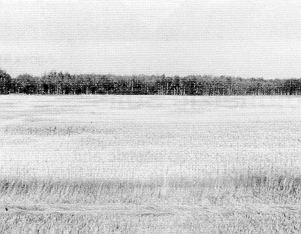
Figure 1. Typical wavy crop pattern associated with Solonetzic soil.
Variation in depth of topsoil, topsoil pH, fertility and subsoil characteristics generally is greater than that occurring in non-Solonetzic soils.
The wavy growth pattern typical of Solonetzic soils indicates that differences in Solonetzic soils occur over relatively short distances. Field investigations have shown that although a hardpan is usually present in the areas of better growth, the reduced hardness allows for improved root penetration and drought tolerance. The difference in hardness is caused by the larger amount of sodium present in the subsoil of the poor growth areas.
Another factor contributing to the wavy growth is the variable depth of topsoil. The good growth areas have more topsoil, resulting in uniform germination and crop establishment. The deeper topsoil also increases moisture storage thereby enhancing drought tolerance.
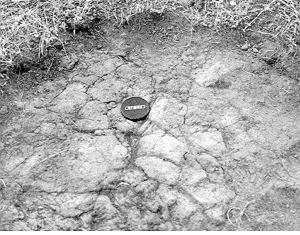
Exposed hardpan of Solonetzic soil.
Although soil pH varies considerably within any field, the variation is much greater in Solonetzic soils. Sampling of good and poor growth areas has shown that good growth areas tend to be more acid (lower pH).
Owing to the shallow topsoil, Solonetzic soils tend to have less total organic matter than non-Solonetzic soils with the result that smaller quantities of nutrients are released during the growing season or when fallowed. A more complete discussion of soil organic matter is presented in the factsheet Soil Organic Matter, Agdex 536- 1.
The overall productivity of Solonetzic soils is lower than that of non-solonetzic soils. Moisture is usually the major limitation to crop production, with the degree of limitation being related to the depth of topsoil and hardness of the hardpan. These features are discussed in the following sections.
Characteristics of Solonetzic Soils
There are three types of Solonetzic soil: the Solonetz, Solodized Solonetz and the Solod. These Solonetzic soils are often associated in a complex manner with non Solonetzic soils, which accounts for the crop's wavy growth pattern.
As indicated previously, Solonetzic soils have formed from parent materials rich in sodium or from materials enriched with sodium. When followed by a net downward movement of groundwater, soluble salts are leached resulting in the formation of the hardpan in the subsoil. These soils are referred to as Solonetz. The Solonetz is characterized by a tough impermeable hardpan which usually occurs within 20 cm (8 in.) of the surface. There is an abrupt interface between the A horizon (topsoil) and the B horizon (subsoil). These soils are relatively uncommon in Alberta.
With continued downward movement of groundwater, gradual leaching of sodium from the hardpan is initiated and disintegration of the tops of columns gradually takes place. This is characterized by the formation of an acidic ashy-white colored soil horizon immediately above the hardpan from which clay and organic matter have been removed. These soils are referred to as Solodized Solonetz. The Solonetzic soils of east-central Alberta are predominantly of this type.
The Solods are the most productive of the Solonetzic soils. Leaching of sodium has resulted in the disintegration of the tops of the columns. This has led to the formation of a deeper topsoil. These soils have an acidic topsoil and a subsoil that breaks apart more readily. Field trials have shown that these soils have a greater potential for deep tillage, particularly subsoiling, than the Solonetz and Solodized Solonetz.
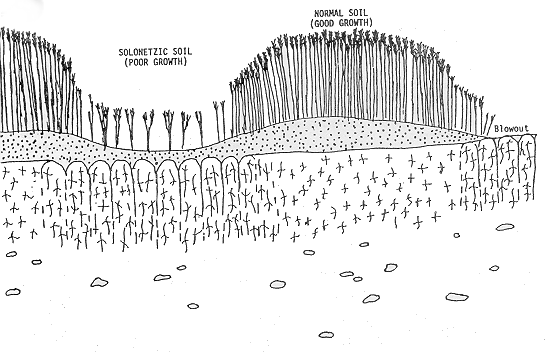
Solonetzic soil associated with a normal soil resulting in wavy crop pattern.
Occurrence
There are about 10 to 12 million acres (4 to 5 million hectares) of Solonetzic soils in Alberta which represent about 30 per cent of the arable land. The low relief plain running mainly north- south through central Alberta from north of Vegreville through Camrose, Daysland, Castor, Coronation, Youngstown, Pollockville and to Brooks in the south is the largest area of Solonetzic soils in Canada. This plain consists of about 7 million acres (3 million hectares) of Solonetzic soils. The Solonetzic soils of the Peace River Region are somewhat different from those of central Alberta in that they are fine textured (high clay) and tend to be predominantly Solods. Significant areas of Solonetzic soils are also found in the Leduc and Westlock areas. Smaller acreages of Solonetzic soils are found in Saskatchewan and Manitoba.
Management of Solonetzic soils
Drainage
Surface drainage should be provided whenever possible to prevent temporary ponding of water. This will allow for more timely cultivation of the entire field and will minimize crop drowning.
Seedbed preparation
Seedbed preparation is relatively difficult on Solonetzic soils since they dry unevenly and if cultivated when wet or after they have dried, they form large clods that are difficult to break down. Although the exact operations required to prepare a good seedbed will vary from year to year, working them during cool weather and when they are moderately dry generally gives the best results. Spring tillage should be shallow and minimal.
Fertilizers
The fertilizer requirements of crops grown on Solonetzic soils are similar to those grown on associated non- Solonetzic soils. The optimum rates of fertilizer application will tend to be lower because of the lower yield potential.
Organic matter
Since crop residues are the major source of soil organic matter, their return to the soil is strongly recommended to improve topsoil structure and tilth. The application of barnyard manure is particularly useful in improving soil tilth in small problem areas.
Forage crops
The production of forage crops on Solonetzic soils can be successful if the appropriate forage is selected and adequately fertilized. Forage crops will eventually increase soil organic matter resulting in better growing conditions for cereal and oilseed crops that follow.
Improvement of Solonetzic Soils
Deep plowing as a means of improving Solonetzic soils was first attempted in Alberta during the 1950s. More recently, subsoiling (ripping) and subsoiling in conjunction with amendments such as lime and gypsum are being evaluated to determine their potential for improving the productivity of these soils.
In the Brown soil zone (refer to the soil zone map), moisture deficit is the major limitation to crop production. For this reason, deep tillage to increase moisture storage may not be economical. In higher precipitation areas, such as the Dark Brown, Black and Gray soil zones, storage of moisture is the major limitation to crop production and thus these soils may have the greatest potential for improvement.
Areas where salts are accumulating on the soil surface are unsuitable for deep tillage since this may encourage further soil salinization. Continuous cropping of the recharge and discharge areas as well as growing crops which have large water requirements are considered to be effective control measures. Soil sampling to determine the suitablity of the soil for deep tillage and to identify the ideal depth of tillage is recommended.
Deep plowing
Important: Call Before you Dig
Buried pipelines and telephone cables may be damaged by deep plowing and subsoiling equipment. The location of pipeline and cables must be identified before the start of field operations. To arrange for free marking of their location, call Alberta 1st Call toll free at 1-800-242-2447 or visit their web site www.alberta1call.com/ |
Deep plowing is a soil mixing process whereby calcium in the form of lime and gypsum in the lime- salt layer is mixed with the hardpan allowing for an exchange reaction to occur. Calcium replaces the sodium on the clay particles thus improving the soil structure and preventing the reformation of the hardpan. In addition to improving soil structure, lime (calcium carbonate) brought to the surface will raise the topsoil pH which will further improve soil productivity, particularly for acid-sensitive crops such as the legumes and barley.
Not all Solonetzic soils are suitable for plowing. The following key soil characteristics need to be considered when determining the suitability for plowing.
- The lime-salt layer must be within plowing depth.
- The sodium content of the lime-salt layer must be sufficiently low to prevent problems in preparing a seedbed when such material is brought to the surface.
- There should be no evidence of the upward movement of saline groundwater.
- Sodic bedrock should be below plowing depth to prevent the incorporation of this material with the topsoil and hardpan.
Other soil characteristics that should be considered include soil texture, presence of stones, topography, percentage of the field that is Solonetzic, soil drainage and topsoil pH.
The moisture content of the subsoil at the time of plowing is critical for achieving a good mix of the hardpan with the lime-salt layer. If the soil is plowed when the subsoil is moist, little mixing will occur and the result is limited improvement in soil productivity. Perennial forages that are to be worked down or stubble land from which the subsoil moisture has been depleted usually present the ideal conditions for deep plowing.
In some situations, crop yields the year after plowing are lower than those of adjacent unplowed areas. This may be particularly true with late fall plowing when there is not enough time available to firm the soil and prepare a seedbed. With late fall plowing, the soil remains open throughout the winter allowing for maximum infiltration of snow melt water, often necessitating delayed seeding.
On some deep plowed soils, a lumpy seedbed may cause uneven germination and crop establishment; however, this condition will improve with time. Some farmers prefer to establish perennial forages after deep plowing, which eliminates the need to prepare a seedbed annually. After several years of forage production, the land may be returned to the production of cereal and oilseed crops.
A reduction in yields may also occur if there is an inadequate concentration of lime or gypsum in the lime-salt layer, or if plowing is too shallow to incorporate a sufficient amount of the lime-salt layer with the hardpan. Soil sampling to identify the suitability of the soil for plowing and the optimum depth of plowing is recommended.
Subsoiling or deep ripping
Important: Call Before you Dig
Buried pipelines and telephone cables may be damaged by deep plowing and subsoiling equipment. The location of pipeline and cables must be identified before the start of field operations. To arrange for free marking of their location, call Alberta 1st Call toll free at 1-800-242-2447 or visit their web site www.alberta1call.com/ |
Subsoiling, as an alternative to deep plowing, has generated considerable interest in the past few years. Field trials have shown significant yield increases on some soils. Research is underway to identify the soils most likely to respond to subsoiling, to determine the longevity of the improved crop growth and to identify the soils which may further benefit from lime or gypsum applications.
Field trials have shown that soils with the following characteristics are considered suitable for subsoiling:
- no evidence of the accumulation of salts on the soil surface
- a soil with at least 7.5 cm (3 in.) of topsoil
- an acidic topsoil
- a soil having a definite hardpan but with moderate to low levels of sodium
- a depth to sodic bedrock greater than the depth of subsoiling
Because little mixing of the soil horizons is accomplished by subsoiling, improved crop growth is largely attributed to the physical shattering of the hardpan; however, substantial mixing of the soil may occur if subsoiling is done when the soil is dry. The degree of shattering may be determined by digging a trench across the subsoiled area. In situations where more complete shattering is desired, subsoiling a second time at an angle to the first pass may be beneficial.
As with plowing, the soil may remain open which will necessitate delayed seeding, particularly with late fall subsoiling. Subsequent field operations should firm the soil and prepare the seedbed. Poor seedbed quality may affect germination and stand establishment; however, this will improve in a year or two.
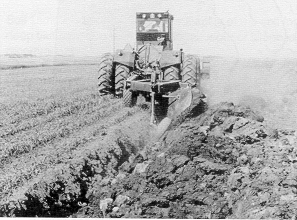
Deep plowing.
The longevity of subsoiling requires further investigation. In some situations there does not appear to be any redevelopment of the hardpan, whereas in other situations improved crop growth is short-lived. The higher sodium content of the subsoil or excessive subsoil moisture at the time of subsoiling may explain the short duration of improved crop growth on some soils.
Deep Tillage Equipment
A number of deep plows and subsoilers have been developed and tested for the improvement of Solonetzic soils.
Deep plows
Several different deep plows have been designed and built in Alberta. Changes in the design have improved penetration, increased plowing depth, improved soil mixing, reduced draft and provided for the salvaging of topsoil. The two topsoil saving plows are experimental units and are not readily available. A brief description of each model is provided below.
Single bottom plow
The simplest of the deep plows is the single bottom plow. This model plows a furrow 75 cm (30 in.) wide to a depth of 60 cm (24 in.). A single moldboard is used to mix the topsoil and hardpan with the lime-salt layer. Because much of the topsoil is lost during the plowing operation, the use of this plow is restricted to soils having little or no topsoil.
Three- layer plow
The three- layer plow was the first attempt to produce a model capable of salvaging topsoil. This pow uses a series of moldboards to transfer the topsoil from the unplowed to the plowed area. This unit is capable of plowing a furrow 60 cm (24 in.) wide and 60 cm (24 in.) deep.
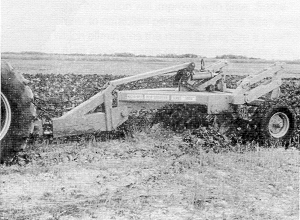
Subsoiling.
Wheel plow
The wheel plow is more effective in salvaging topsoil, has a lower draft and is more capable of maintaining a uniform depth of penetration. This model uses a large rotating wheel to transfer the topsoil from the unplowed to the plowed area. This unit is capable of plowing a furrow 75 cm (30 in.) wide and 75 cm (30 in.) deep.
Subsoilers
Because of the cost and time involved with deep plowing, subsoilers were introduced as an alternative. A number of different subsoilers are commercially available. Most models use a parabolic shank, whereas other models have varying shank configurations.
Based on five years of crop response data from one trial, the parabolic design resulted in greater disruption of the hardpan and consequently greater crop yield than that obtained with the bentleg design. With solonetzic soils some mixing of the soil is desirable whereas the bentleg design may be more appropriate for soils where minimal mixing is desired.
Since their introduction, most of the modifications to subsoilers have involved shank design and spacing to improve penetration and depth. When first introduced, shanks were spaced on 50 cm (20 in.) centres and have gradually been increased with one imported unit using 150 cm (60 in.) centres. Another unit introduced from Europe uses 50 cm (20 in.) centres. Field observations have shown the shattering is reduced with increased shank spacing.
To prevent structural damage from rocks, subsoilers are equipped with either a shear pin or a spring trip assembly. Machines equipped with shear pins can maintain a more uniform depth of operation; however, a spring reset mechanism provides an extra degree of protection for the tractor's drive train.
Crop Response to Deep Tillage
Crop responses in the higher precipitation areas such as the Dark Gray, Black and Thin Black soil zones tend to be greater than those of the drier regions such as the Brown and Dark Brown soil zones. Yields shown in table 1 compare crop response (wheat, oats, barley, canola, rye and mixed grains) obtained by deep tillage (plowing and subsoiling) for the different soil zones. The data presented for the Brown, Dark Brown and Thin Black soil zones represent crop responses predominantly obtained from deep plowing, whereas crop responses for the Black and Dark Gray soil zones were predominantly obtained with subsoiling.
Research has shown that increased soil moisture storage is largely responsible for the improved growth. Another contributing factor may be that the soils in the higher precipitation areas are more thoroughly leached and much of the sodium has leached deeper in the soil. These soils will tend to have a thicker topsoil and the sodium content of the hardpan generally will be lower making them more suitable for deep tillage.
The smaller yield increase in the high rainfall areas may be due to poor topsoil tilth in the first year or two after deep tillage. This situation, which may persist for several years, has a greater effect on average yields for a soil zone where only a few years of data are available as compared to another soil zone where many years of data have been obtained.
Because of longer crop rotations in the high precipitation areas, yield increases (table 1) may be obtained on a yearly basis. In the drier regions (Brown soil zone) where a crop-fallow rotation is common, yield increases are obtained every second year.
Table 1: Response of cereals and oilseeds to deep tillage by soil zone
|
| Yield increase
(cwt/yr) | Number of
Site Years |
| Brown | 2.5 | 111 |
| Dark Brown | 3.7 | 268 |
| Thin Black | 3.6 | 118 |
| Black | 3.2 | 55 |
| Dark Gray | 2.3 | 7 |
| Gray | 3.4 | 10 |
When interpreting yield responses, one should note the number of site-years. For example, a yield increase of 10 bu/ac based on 15 site-years can be viewed with more confidence than a 10 bu/ac increase based on a few site- years. One site-year is defined as one site which was harvested one year whereas five site- years of data could be obtained from either one site monitored for five years, five sites monitored for one year or any combination totalling five. The greater the number of site-years of yield response, the more confidence one can have in that value.
Yield responses under farm conditions may be greater than those obtained from plot trials for the following reasons:
- When entire fields are deep plowed or subsoiled, timing of tillage and choice of implements are based on what is considered to be the best alternative for those field conditions. With plot trials involving 5 or 10 acres in a large field, the timing of tillage and choice of implement are often based on what is considered to be the best for the untreated or check area. This has often resulted in deep tilled plots being mudded in and consequently the results are biased in favor of the check area.
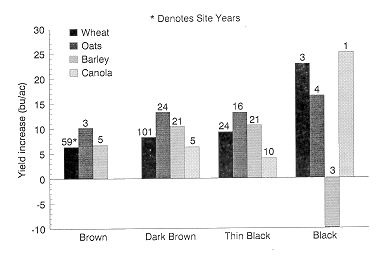
Crop response to deep plowing
- When harvesting check areas with typical harvesting equipment, losses may be greater than where square yard cuts are used to determine crop yields. In swathing lower yielding crops on the check areas, the swath often drops to the ground resulting in increased harvest losses. As a result, the check yields may be lower than those obtained by square yard cuts. In such situations, the yield response a farmer might expect from a deep tillage treatment would be greater than that obtained by square yard cuts.
- Deep plowing
Most deep plowing trials were established in the Brown and Dark Brown soil zones because the lime- salt layer is relatively shallow. Trial results using topsoil-saving plows have been combined with those obtained with the single bottom plows and are presented in figure 7. The yield results show that crop response increases with increasing precipitation. The number of site- years must be considered when interpreting this data.
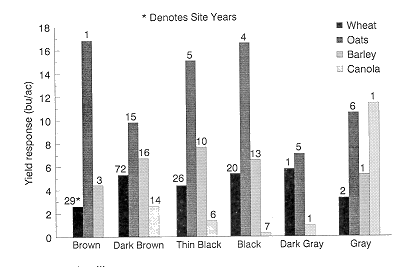
Crop response to subsoiling
Crop maturity may be delayed on deep- plowed plots. This situation usually arises when the increased moisture present in deep- plowed soils allows for normal crop development while adjacent unplowed areas may suffer from stress during periods of drought that cause premature ripening of the crop. The negative crop response obtained with barley in the Black soil zone (figure 7) was due to peculiar circumstances and should not be interpreted to suggest barley does not respond to deep plowing.
Yield increases of 1.1 bu/ac and 12.3 bu/ac of fall rye were obtained in the Brown and Dark Brown soil zones respectively, based on three and five site- years of data respectively. Mixed crops involving various combinations of wheat, oats and barley have also been grown. Yield increases of 10.7, 13.3, 12.3 and 9.4 bu/ac were obtained in the Brown, Dark Brown, Thin Black, and Black soil zones respectively. These yield increases were based on one, three, four and four site- years respectively.
Subsoiling
Optimum shattering of the hardpan occurs when the subsoil is dry. Where crop responses have been marginal or increased yields are short-lived, subsoiling was likely done when the subsoil was too wet.
The number of site-years of data is less than for deep plowing and consequently the results cannot be interpreted with the same confidence.
Crop germination and establishment the year after deep tillage may be adversely affected, particularly when subsoiling is done in late summer or fall. In these situations, water infiltration from snowmelt may cause the fields to be very wet thereby necessitating delayed seeding or seeding into a poor quality seedbed. Occasionally these soils may have to be fallowed the following year.
Improved crop growth following subsoiling is generally considered to be the result of the physical shattering of the hardpan, which allows for increased water penetration into the subsoil. This may also accelerate the leaching of sodium from the subsoil thereby further reducing the possibility of reformation of the hardpan.
There is no evidence the hardpan will reform, providing the soil's characteristics make it suitable for subsoiling and hardpan is thoroughly shattered. In one trial, yield from the subsoiled tratment continues to be significantly greater that the check after 14 years. This site along with others with more than 10 years of cropping history indicates subsoiling may have a long- term benefit, providing the hardpan is thoroughly shattered. In some instances, producers are using multiple operations to achieve more thorough shattering of the hardpan or to increase the depth of shank penetration. A few producers install larger points on the subsoiler shanks for the second or third operation to elevate the calcium from the lime- salt layer in an attempt to improve the chemical amelioration of the hardpan. This procedure may be considered in areas where the lime-salt horizon is within the depth of penetration of the subsoiler.
Subsoiling and liming
A limited number of trials have been established to measure crop responses from a combination of subsoiling and liming. Results presented in table 2 show the yield increase of wheat and barley obtained by liming, subsoiling and subsoiling and liming. For moderately tolerant crops such as wheat, lime alone or lime on subsoiled plots resulted in only marginal yield increases (1.8 and 1.1 bu/ac respectively) whereas for moderately sensitive crops such as barley, yield increases to lime alone is substantially higher (6.3 bu/ac). The relatively small increase in yield of barley to lime on subsoiled plots (2.4 bu/ac) is likely due to the elevation of subsoil during the subsoiling operation. This increase in topsoil pH may be sufficient to allow barley growth without limitation because of soil acidity. Larger yield increases can be expected if more acid-sensitive crops such as alfalfa or sweet clover are grown. For Solonetzic soils with strongly acid topsoils (pH less than 5.5), yield increases from lime would be greater than those presented in this table.
Table 2: Wheat and barley response to subsoiling and liming
 | Yield Increase (bu/ac) |
 | Wheat* | Barley** |
| Limed | 1.8 | 6.3 |
| Subsoiled | 6.4 | 5.6 |
| Subsoiled and limed | 7.5 | 8.0 |
| * Based on 36 site-years ** Based on 20 site-years |
Based on 38 trials, subsoiling increased topsoil pH by 0.4 units. At some locations increases as great as 2.0 units have been recorded. Soils that are very dry at the time of subsoiling or soils where the lime salt layer is shallow may experience the greatest change in pH. Subsoiling Solonetzic soils with moderately acid topsoil may increase the range of crops that can be successfully grown on these soils.
When sampling soil to determine lime requirements for Solonetzic soils, it is recommended that two composite topsoil samples be taken, one representing areas of good growth and the second representing areas of poor growth. If sampling is done during the summer, the crop can be used to identify the good and poor growth areas. Research has shown solonetzic soils are more variable than other soils; therefore, sampling good and poor areas separately will provide a more accurate assessment of the need for lime.
There has been no research conducted to evaluate the timing of lime application in relation to subsoiling. Some farmers have experienced difficulty in pulling the lime spreader after subsoiling because the soft field conditions limit traction. Subsoiling after liming may allow for incorporation of lime into the hardpan thereby improving the calcium supply.
Management of Deep-Tilled Soils
The following should be considered when developing a cropping program for deep plowed and subsoiled areas:
- Use a heavy float to level the soil and help break apart large lumps of soil for the first operation after deep plowing or subsoiling. Some producers prefer to pull several sections of heavy harrows in tandem behind a subsoiler, or deep plow to facilitate subsequent workdown.
- Follow this initial operation by several passes with a heavy disc as soon as possible after deep tillage to prevent further drying of the soil and to facilitate workdown. Where the soil is not excessively lumpy, chisel plows or field cultivators may be used to work the field down and firm the soil. The number of passes necessary to prepare a seedbed is dependent on the moisture content of the soil at the time of deep tillage, as well as on individual soil characteristics.
- Some producers prefer to fallow the land after deep tillage to allow adequate time for seedbed preparation. This may eliminate yield reductions which are caused by poor seedbed quality resulting from late fall deep tillage.
- Because deep-tilled soils tend to remain open allowing for moisture entry into the subsoil, some producers suggest using a two wheel driver tractor with good flotation, or a four wheel drive for timely soil tillage.
- Despite poor seedbed quality which may occur after deep tillage, fall seeded crops or forage crops have been grown successfully. Fall seeded crops germinate at a time of the year when moisture conditions are more favorable allowing for better crop establishment. Perennial forages will germinate whenever moisture conditions are suitable and eliminate the need for annual seeding. The planting of small seeded crops such as canola or flax should be avoided until seedbed quality improves.
- The increased moisture stored in deep-tilled soils has enabled some producers to continuous crop in areas where fallow has traditionally been used. Increased crop residues and a reduction in tillage using continuous cropping will increase soil organic matter. This should minimize the difficulty often experienced with seedbed preparation.
- To realize the potential increase in productivity, soil fertility must receive increased attention. Increased crop yields and less frequent fallowing will necessitate increased rates of fertilization. Soil sampling has shown the phosphorus soil test values are significantly lower on some deep- tilled soils. Field trials have shown yields will increase with higher rates of phosphate fertilization, however insufficient data is available to formulate any conclusions. No research has been done to evaluate the response of crops to nitrogen fertilization; however, it can be assumed that soils with an increased yield potential or soils where crop rotations are being extended will have a higher nitrogen requirement.
- Cropping alternatives are generally increased following deep tillage. Crops that previously could not be successfully grown because of their sensitivity to drought, excess moisture or soil acidity may be grown more successfully after deep tillage, particularly deep plowing.
Soil Testing
Not all soils are considered suitable for deep tillage; in fact, some soils may experience a decrease in productivity or be put out of production for several years. Therefore, all fields should be tested before any deep tillage is performed. Soil sampling with a large coring truck is necessary to determine the suitability of the soil for deep plowing; for subsoiling, sampling the topsoil and subsoil by hand is adequate. For further information on soil testing contact your district agriculturist.
Economics
No reliable estimate is available for the cost of deep plowing because most of the plowing to date has involved 5 or 10 acre demonstrations, however, estimates of $100 to $150 per acre have been made. Assuming a yield increase of 8.5 bu/ac of wheat in the Dark Brown soil zone and wheat valued at $4/bu, a pay- back period of 4 years would be required.
The cost of subsoiling varies between $40 and $45 per acre including the cost of subsequent workdown. Assuming an increase of 5.0 bu/ac of wheat in the Dark Brown soil zone, a pay-back period of 2.1 years would be required if wheat were valued at $4/bu.
These pay- back periods will be extended if interest charges are included or the field is fallowed periodically. In drier regions, the reduced crop responses will be offset by a lower cost of plowing or deep subsoiling because of the shallower depth of the soil profile; in higher precipitation areas, the increased cost of plowing or subsoiling will be compensated through increased crop responses.
Irrigation
The soils that are best suited for irrigation are low in salts, well drained, and have adequate water intake rates and moisture storage capacity. Solonetzic soils are often high in salts, especially sodium salts, and have low water intake rates. Root development and water uptake are restricted due to moderate to high levels of salinity within the root zone, resulting in increased crop stress and depressed yield. The productive capability of an entire field diminishes as the proportion of less productive Solonetzic soils increases. Low productive capability and extreme variability in yield greatly increases the risks associated with production of the most commonly irrigated crops. Land units containing 30 per cent or more Solonetzic soils are rated non-irrigable under existing land classification standards.
Careful irrigation management is needed for irrigating land that is characterized by less than 30 per cent Solonetzic soils. Apply water at low rates to avoid surface ponding, runoff, or a rise of the water table; but apply water in sufficient amounts to meet crop moisture requirements.
Prepared by:
J. Lickacz
Soil Improvement Section
Soil and Crop Management Branch
Edmonton, Alberta, Canada
Source: Agdex 518-8. Revised January 1993. |
|